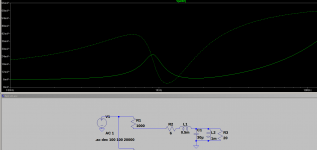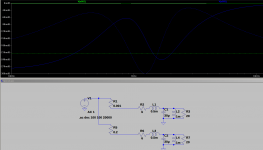That statement is more in line with what I was thinking.So with actual good caps, a designer may be able with some tweeter to notice an hearable difference when designing a new filter...
At Galu,
No challenge, just the wisch to understand and you seem to know and have a techical background as you helped me already elsewhere ? TEN what, not sure I understood what you meant here ?
FWIW, I personally don't think your question is off topic and I believe we sharenthe same desire to understand more. I can illustrate it as this:
Some npe from the beginning of the 80s had already smooth and rough foil so DF (loss factor) at 5k for instance can be 5% or less for the smooth foil, the double 10% for rough foil as all the less expensive npe had 10% as soon as 1k hz.
Now the best non polar lytics aka smooth foil has 2.5% from the datasheets and it is consistent more or less from 1k to 10k.... The rough are said to be 5% at 1k.
But the less expensive npe have still 10% DF and variation can be as high as 20% with few hundred uF...
So an enthusiast as us can legitimly if a designer too' that into acount when it comes to understand a design AND when the easy temptation of upgrading is on the table. The original question makes a lot of sense to me as I have small knowledge (understand negligible)...
Not so far away I asked for instance about MKC (polycarbonate) as an upgrade and iirc AllenB and Lozjek reassure me I was on a false path as long as it was about refurbishing a 40 years old filter made with lytics...
No challenge, just the wisch to understand and you seem to know and have a techical background as you helped me already elsewhere ? TEN what, not sure I understood what you meant here ?
FWIW, I personally don't think your question is off topic and I believe we sharenthe same desire to understand more. I can illustrate it as this:
Some npe from the beginning of the 80s had already smooth and rough foil so DF (loss factor) at 5k for instance can be 5% or less for the smooth foil, the double 10% for rough foil as all the less expensive npe had 10% as soon as 1k hz.
Now the best non polar lytics aka smooth foil has 2.5% from the datasheets and it is consistent more or less from 1k to 10k.... The rough are said to be 5% at 1k.
But the less expensive npe have still 10% DF and variation can be as high as 20% with few hundred uF...
So an enthusiast as us can legitimly if a designer too' that into acount when it comes to understand a design AND when the easy temptation of upgrading is on the table. The original question makes a lot of sense to me as I have small knowledge (understand negligible)...
Not so far away I asked for instance about MKC (polycarbonate) as an upgrade and iirc AllenB and Lozjek reassure me I was on a false path as long as it was about refurbishing a 40 years old filter made with lytics...
Last edited:
You came back at me with TEN questions (count the question marks!).TEN what, not sure I understood what you meant here ?

We are not in disagreement about anything, so let's part as friends. Although I'm technically aware of capacitor parameters such as dissipation factor, I'm not too troubled by them. Give me a high voltage polypropylene capacitor for my loudspeaker crossover and I'm as happy as Larry! We do both share the desire to learn more, but I'll leave the discussion of capacitor 'sound' entirely in your hands. 😎
I will add : at the lowest price !
Definitly, MKP and the highest voltage rating is the easiest answer and a no brainer indeed... too bad for the 9 questions left 😛
Definitly, MKP and the highest voltage rating is the easiest answer and a no brainer indeed... too bad for the 9 questions left 😛
Last edited:
AllenB,
Is there a typical self resonance requency (fr) according the dielectric type or/and the amount of capacitance.... the voltage rating ? Is it here where "the sound of capacitors" differs from 2 brands ?
Below the fr cap, the amount of capacitance acts as a high pass AND above the fr cap, the cap will act partially as a low pass with AC signals ?
My basic understanding is the ESR of a mkp is frequency linear so is its DF... low, flat, simple for designing. While esr increases with high frequency with some papers and MKT introducing more DF (as ESR is an important part of the DF calcul) : can I simplify like that ?
OR: the x" is as important as the ESR in the DF percent result, i.e. stop to look at ESR in datasheet, just look at the DF at the frequencies you use the cap in the XO ?
That's for the technical but then related to the sound in real life and the magnitude of importance : just forgett upgrading a cap in a ready made filter cause it's so negligeable whatever the voltage rating, the dielectric (i.e. modern caps are good enough whatever the dielectric when it comes to upgrades/refurbishing)? ( I'm prompt to follow the simple rule : change just when you need with the same caps if needed... so when the lytic is old and if you have the exact capacitance--- hard because of the capacitance tolerance)
Sorry too much questions as already said. One could claim, stop upgrading caps but I have the feeling it will not stop questions as the original one as far there is a minimum understanding in the objective parameters (science sided and not "how sounds capacitors)...
Is there a typical self resonance requency (fr) according the dielectric type or/and the amount of capacitance.... the voltage rating ? Is it here where "the sound of capacitors" differs from 2 brands ?
Below the fr cap, the amount of capacitance acts as a high pass AND above the fr cap, the cap will act partially as a low pass with AC signals ?
My basic understanding is the ESR of a mkp is frequency linear so is its DF... low, flat, simple for designing. While esr increases with high frequency with some papers and MKT introducing more DF (as ESR is an important part of the DF calcul) : can I simplify like that ?
OR: the x" is as important as the ESR in the DF percent result, i.e. stop to look at ESR in datasheet, just look at the DF at the frequencies you use the cap in the XO ?
That's for the technical but then related to the sound in real life and the magnitude of importance : just forgett upgrading a cap in a ready made filter cause it's so negligeable whatever the voltage rating, the dielectric (i.e. modern caps are good enough whatever the dielectric when it comes to upgrades/refurbishing)? ( I'm prompt to follow the simple rule : change just when you need with the same caps if needed... so when the lytic is old and if you have the exact capacitance--- hard because of the capacitance tolerance)
Sorry too much questions as already said. One could claim, stop upgrading caps but I have the feeling it will not stop questions as the original one as far there is a minimum understanding in the objective parameters (science sided and not "how sounds capacitors)...
Not at all, I was merely agreeing and expanding 😉Sorry if my question was 'off topic'.
Normal electronic design will swamp the parasitics when appropriate. Parasitics are not normally to be relied upon to be consistent, well positioned, or linear (especially in resonant circuits), (if any of that matters in a given usage). Of course, it can always be measured and figured in. I've simmed an example to suggest the kind of magnitude that might be seen.then will compensate with some other factors, esr of an inductor and so on ?
It could be fortunate that tweeter circuits often have series resistance.
Capacitors do typically show a higher impedance at higher frequencies in addition to bottoming out where DF=1. The increase involves ESL. You mention self-resonance.a higher ESR as frequencies increase
It is worth noting that this isn't typical within the audio band and I'd want to see for myself if it was claimed to be a problem.
Take it in context of the circuit. This includes not only circuit impedance in general, but the influence of the component on the circuit nodes that matter.the x" is as important as the ESR in the DF percent result
Attachments
Thank you AlenB,
I have to digest it and translate it in how much it is important or not when it comes to a Mundorf vs a Solen vs a Clarity. When one see the price of the copper foil caps from Jantzen they call amber, I think we hit the sky... the price is simply ridiculous as Duelund is imho... a cheap mkp will do it for my wallet and a smooth foil Elko if area is lacking on the verroboard. MKT seems tricky to master... and bad npe has a DF of 20 above 2 or 3 hundred uF... so a mkp (cost and area no objects) may change the design too much on the bad side if already good enough... and even worse with a mkt instead the hundred uF of lytics we see in the mids as serie high pass 🙁 !
Btw, hope these attachments can also help someone in the learning process. Understanding more in always a pleasure with a hobby.
Which is crazy for me is people want to change the front tyres for slick F1s while staying with Massey Fergusson tyres behind in an upgrading process for the paradise road... where the designer did it fine enough for a good road travel ...😱
I have to digest it and translate it in how much it is important or not when it comes to a Mundorf vs a Solen vs a Clarity. When one see the price of the copper foil caps from Jantzen they call amber, I think we hit the sky... the price is simply ridiculous as Duelund is imho... a cheap mkp will do it for my wallet and a smooth foil Elko if area is lacking on the verroboard. MKT seems tricky to master... and bad npe has a DF of 20 above 2 or 3 hundred uF... so a mkp (cost and area no objects) may change the design too much on the bad side if already good enough... and even worse with a mkt instead the hundred uF of lytics we see in the mids as serie high pass 🙁 !
Btw, hope these attachments can also help someone in the learning process. Understanding more in always a pleasure with a hobby.
Which is crazy for me is people want to change the front tyres for slick F1s while staying with Massey Fergusson tyres behind in an upgrading process for the paradise road... where the designer did it fine enough for a good road travel ...😱
Attachments
- Home
- Loudspeakers
- Multi-Way
- Upgrading Capacitors

